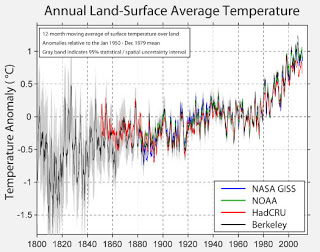The new study does not try to determine the cause of global warming, that is how much is from human causes.
The Nextbigfuture position is that outdoor air pollution is the immediate health and economic threat that is causing the premature death of 1.3 million people each year and birth defects and other disease and sickness.
The actions to correct air pollution largely overlap with the steps to mitigate any possible global warming. So fix the clear problem of air pollution and you would also take to fix global warming.
* get 700 million soot free cookers to the developing world. Costs about $70 billion. Would save 1.9 million lives per year from indoor air pollution and the lowered soot would equal an 8% of current carbon dioxide reduction. It would also save more lives with solar cookers by allowing developing people to boil more water without considering fuel costs and reduce health problems and death from unclean water
* Uprate existing nuclear power plands and build more nuclear power
The Berkeley Earth Surface Temperature study finds reliable evidence of a rise in the average world land temperature of approximately 1°C since the mid-1950s.
Analyzing temperature data from 15 sources, in some cases going as far back as 1800, the Berkeley Earth study directly addressed scientific concerns raised by skeptics, including the urban heat island effect, poor station quality, and the risk of data selection bias.
The Berkeley Earth team is making these preliminary results public, together with the programs and data set in order to invite additional scrutiny as part of the peer review process.
The Berkeley Earth study concludes that:
− The urban heat island effect is locally large and real, but does not contribute significantly to the average land temperature rise. That’s because the urban regions of the Earth amount to less than 1% of the land area.− About 1/3 of temperature sites around the world reported global cooling over the past 70 years (including much of the United States and northern Europe). But 2/3 of the sites show warming. Individual temperature histories reported from a single location are frequently noisy and/or unreliable, and it is always necessary to compare and combine many records to understand the true pattern of global warming.
“The large number of sites reporting cooling might help explain some of the skepticism of global warming,” Rohde commented. “Global warming is too slow for humans to feel directly, and if your local weather man tells you that temperatures are the same or cooler than they were a hundred years ago it is easy to believe him.” In fact, it is very hard to measure weather consistently over decades and centuries, and the presence of sites reporting cooling is a symptom of the noise and local variations that can creep in. A good determination of the rise in global land temperatures can’t be done with just a few stations: it takes hundreds or better, thousands of stations to detect and measure the average warming. Only when many nearby thermometers reproduce the same patterns can we know that the measurements were reliably made.
Four scientific papers setting out these conclusions have been submitted for peer review and will form part of the literature for the next IPCC report on Climate Change.
If you liked this article, please give it a quick review on ycombinator or StumbleUpon. Thanks

Brian Wang is a Futurist Thought Leader and a popular Science blogger with 1 million readers per month. His blog Nextbigfuture.com is ranked #1 Science News Blog. It covers many disruptive technology and trends including Space, Robotics, Artificial Intelligence, Medicine, Anti-aging Biotechnology, and Nanotechnology.
Known for identifying cutting edge technologies, he is currently a Co-Founder of a startup and fundraiser for high potential early-stage companies. He is the Head of Research for Allocations for deep technology investments and an Angel Investor at Space Angels.
A frequent speaker at corporations, he has been a TEDx speaker, a Singularity University speaker and guest at numerous interviews for radio and podcasts. He is open to public speaking and advising engagements.


